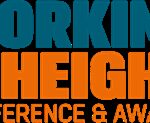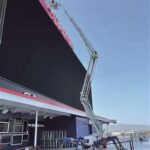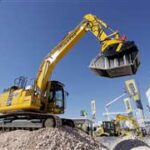Some jobs don’t just need height.
They need height + distance + precision—the trifecta of aerial work.
If you’re facing massive open spaces, awkward structures, or just a stubborn project manager asking for “more reach,” you need one thing:
A telescopic boom lift.
Let’s unpack what they are, what they’re great at, and why they might just be your next best friend on the job site.
🛠️ First, What Is a Telescopic Boom Lift?
A telescopic boom lift (also called a straight boom lift) is a type of aerial work platform that extends in a straight line, just like a telescope sliding outward.
Think:
-
A giant mechanical arm.
-
Extending smooth and far.
-
No crazy joints, no bending in weird directions.
-
Pure reach and simplicity.
It’s built for maximum horizontal and vertical extension, with speed and stability.
🏗️ Where Telescopic Booms Dominate
If you need to:
-
Reach the far edge of a roof
-
Paint or fix high stadium walls
-
Install signage on tall, wide buildings
-
Perform bridge inspections
-
Work around oil fields or shipyards
👉 Telescopic booms are the gold standard.
Why? Because they reach farther faster than any other lift type—often while staying stable even on rough terrain.
📈 How Much Reach Are We Talking?
Typical reach ranges:
-
Platform heights: 40 ft to 185 ft (12–56 meters)
-
Horizontal outreach: Up to 80 ft or more on the biggest models
Example beasts:
-
Genie SX-180: 180 ft up, 80 ft out
-
JLG 1850SJ: 185 ft up, 80+ ft out
-
Dingli BT44ERT: 144 ft up, modular electric drive
These machines don’t just go high—they go long, clearing obstacles that articulated booms would struggle with.
📐 How Telescopic and Articulating Booms Compare
| Feature | Telescopic Boom | Articulating Boom |
|---|---|---|
| Movement | Straight out and up | Bends around obstacles |
| Reach | Maximum horizontal range | Better “up and over” reach |
| Best for | Open spaces, long access | Confined or complex work areas |
| Speed | Faster deployment | Slower, more precise |
| Maneuverability | Lower (needs clearance) | Higher (tight quarters expert) |
In short:
-
Big open space? Telescopic.
-
Tight, twisty indoor site? Articulating.
🌟 Pros of Telescopic Boom Lifts
✅ Unbeatable straight-line reach
✅ Higher platform capacities (many rated for 500–1,000+ lbs)
✅ Ideal for rough terrain with big tires, diesel/hybrid engines
✅ Faster lift speed = faster job completion
For jobs that need simple, efficient elevation across long distances—nothing beats a straight shooter.
⚠️ Things to Watch Out For
-
Turning Radius: Big machines need big turning circles. Plan ahead.
-
Overhead Clearance: The boom needs space to extend fully without snagging wires, pipes, etc.
-
Wind Sensitivity: The higher you go, the more the wind matters. Follow the rated maximums strictly.
Also, driving at full extension?
Some models allow it. Some lock movement for safety. Always check your manual.
🔥 Who Loves Telescopic Booms?
-
Steel erectors installing massive girders
-
Window washers for skyscrapers
-
Bridge inspectors
-
Outdoor construction crews
-
Oil and gas field maintenance teams
If your work is more “big sky, open land” than “tight warehouse,” a telescopic boom lift is your best bet.
🏁 Final Thoughts
When reach matters most—whether it’s vertical, horizontal, or that awkward diagonal to the far side of a structure—telescopic boom lifts are the solution.
They’re fast, stable, and simple.
Built for open space dominance, not tight urban ninja work.
Point, extend, lift, win.
If your job says “go farther,” answer with the straight power of a telescopic boom.




